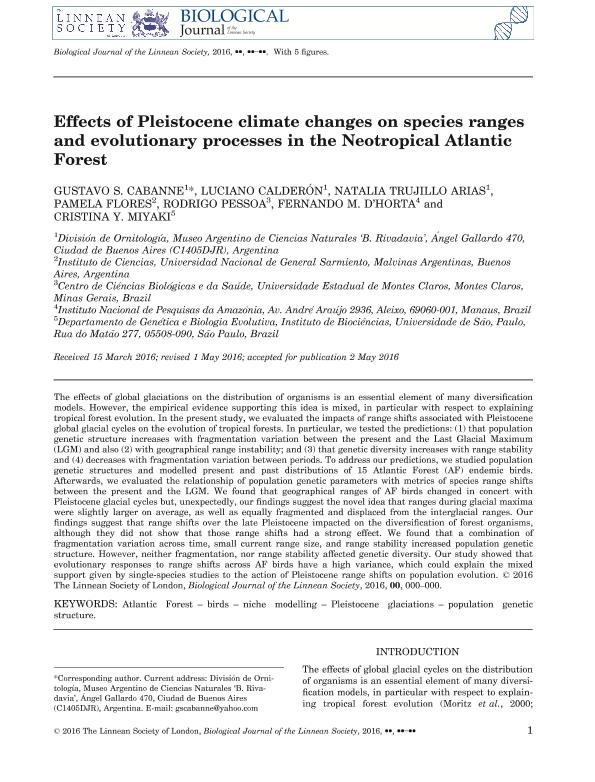Artículo
Effects of Pleistocene climate changes on species ranges and evolutionary processes in the Neotropical Atlantic Forest
Cabanne, Gustavo Sebastián ; Calderón, Pablo Luciano Sebastian
; Calderón, Pablo Luciano Sebastian ; Trujillo Arias, Natalia
; Trujillo Arias, Natalia ; Flores, Pamela; Pessoa, Rodrigo; d'Horta, Fernando M.; Miyaki, Cristina Y.
; Flores, Pamela; Pessoa, Rodrigo; d'Horta, Fernando M.; Miyaki, Cristina Y.
 ; Calderón, Pablo Luciano Sebastian
; Calderón, Pablo Luciano Sebastian ; Trujillo Arias, Natalia
; Trujillo Arias, Natalia ; Flores, Pamela; Pessoa, Rodrigo; d'Horta, Fernando M.; Miyaki, Cristina Y.
; Flores, Pamela; Pessoa, Rodrigo; d'Horta, Fernando M.; Miyaki, Cristina Y.
Fecha de publicación:
12/2016
Editorial:
Wiley Blackwell Publishing, Inc
Revista:
Biological Journal of The Linnean Society
ISSN:
0024-4066
Idioma:
Inglés
Tipo de recurso:
Artículo publicado
Clasificación temática:
Resumen
The effects of global glaciations on the distribution of organisms is an essential element of many diversification models. However, the empirical evidence supporting this idea is mixed, in particular with respect to explaining tropical forest evolution. In the present study, we evaluated the impacts of range shifts associated with Pleistocene global glacial cycles on the evolution of tropical forests. In particular, we tested the predictions: (1) that population genetic structure increases with fragmentation variation between the present and the Last Glacial Maximum (LGM) and also (2) with geographical range instability; and (3) that genetic diversity increases with range stability and (4) decreases with fragmentation variation between periods. To address our predictions, we studied population genetic structures and modelled present and past distributions of 15 Atlantic Forest (AF) endemic birds. Afterwards, we evaluated the relationship of population genetic parameters with metrics of species range shifts between the present and the LGM. We found that geographical ranges of AF birds changed in concert with Pleistocene glacial cycles but, unexpectedly, our findings suggest the novel idea that ranges during glacial maxima were slightly larger on average, as well as equally fragmented and displaced from the interglacial ranges. Our findings suggest that range shifts over the late Pleistocene impacted on the diversification of forest organisms, although they did not show that those range shifts had a strong effect. We found that a combination of fragmentation variation across time, small current range size, and range stability increased population genetic structure. However, neither fragmentation, nor range stability affected genetic diversity. Our study showed that evolutionary responses to range shifts across AF birds have a high variance, which could explain the mixed support given by single-species studies to the action of Pleistocene range shifts on population evolution.
Archivos asociados
Licencia
Identificadores
Colecciones
Articulos(MACNBR)
Articulos de MUSEO ARG.DE CS.NAT "BERNARDINO RIVADAVIA"
Articulos de MUSEO ARG.DE CS.NAT "BERNARDINO RIVADAVIA"
Citación
Cabanne, Gustavo Sebastián; Calderón, Pablo Luciano Sebastian; Trujillo Arias, Natalia; Flores, Pamela; Pessoa, Rodrigo; et al.; Effects of Pleistocene climate changes on species ranges and evolutionary processes in the Neotropical Atlantic Forest; Wiley Blackwell Publishing, Inc; Biological Journal of The Linnean Society; 119; 4; 12-2016; 856-872
Compartir
Altmétricas



